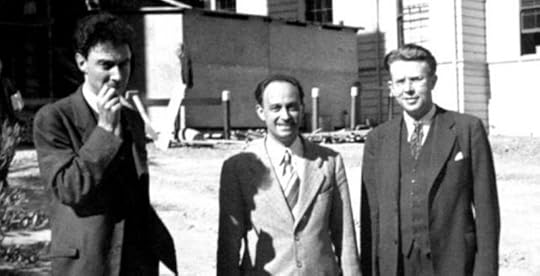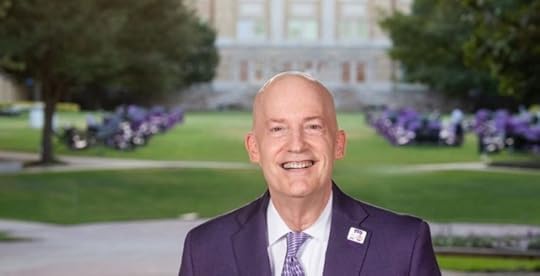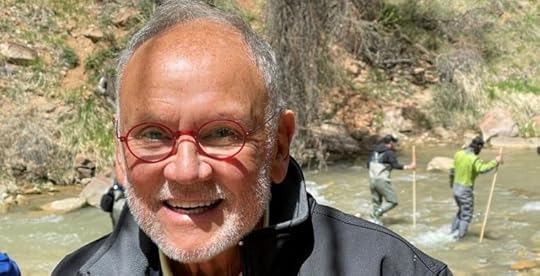Michael Lee Stallard's Blog
November 10, 2025
Blanchard Community Webinar on Connection Culture
Join me on November 19

If you have ever wanted to learn more about how the power of connection can help you and your team become smarter, happier, more productive and more resilient to cope with stress, then I have good news for you.
Join me for a free, virtual book club event hosted by the Blanchard Community as we discuss tips from my book, Connection Culture: The Competitive Advantage of Shared Identity, Empathy and Understanding at Work (2nd edition).
Date: November 19, 2025Time: 3:00-3:45 pm CSTCost: FreeYou can find all the details and register here.
The post Blanchard Community Webinar on Connection Culture appeared first on Michael Lee Stallard.
November 7, 2025
The Surprising Leadership of J. Robert Oppenheimer

This morning, I had a Zoom meeting with Jeff Moore of Moore Leadership. He was the longtime coach of the University of Texas men’s tennis team. Now Jeff is writing about leadership and he’s teaching and coaching leaders.
I’m impressed with Jeff and his work, and thought I’d share a great article he wrote that I especially enjoyed. It’s about how J. Robert Oppenheimer led the team of scientists and engineers of The Manhattan Project to make the atomic bomb before the Nazi’s did. Here’s the link to Jeff’s article, “Leadership Lessons from Oppie.”
Photo of J. Robert Oppenheimer, Enrico Fermi, and Ernest Lawrence (courtesy the Lawrence Berkeley National Laboratory ) via the U.S. Department of Energy – Office of History and Heritage Resources
The post The Surprising Leadership of J. Robert Oppenheimer appeared first on Michael Lee Stallard.
August 2, 2025
Shades of Trust: Real Conversations on Connection, Character & Compassion
Webinar on August 28, 2025

Think about a time when you were working in a team with members who didn’t trust each other.
Lack of trust presents a host of challenges and can ultimately derail the effectiveness of an otherwise talented team.
But, in order to trust people, you first have to connect with them. And in order to connect with them, you have to be open.
It takes courage and vulnerability to connect. The results though are worth it.
I’m looking forward to sharing more about the relationship between connection and trust in an upcoming webinar titled “Shades of Trust: Real Conversations on Connection, Character & Compassion.” The event is free and features a wonderful panel of speakers.
Register today to join me on Thursday, Aug. 28th, from 12:00-1:00 pm Pacific Time.
The post Shades of Trust: Real Conversations on Connection, Character & Compassion appeared first on Michael Lee Stallard.
June 14, 2025
The Life and Leadership of Quiet Revolutionary Frances Hesselbein

I have a film recommendation for you: the beautiful and timely award-winning documentary Defining Moments: The Life and Leadership of Quiet Revolutionary Frances Hesselbein. I attended a screening in New York City in May and it deeply resonated with me. If you are not yet familiar with Frances Hesselbein, I can tell you she was a positive, connection-minded leader and one to emulate.
Leader, advisor, mentor, encourager, and friend to many—from young Girls Scouts in western Pennsylvania, across the US and the world, to cadets and officers in the military and at the United States Military Academy at West Point, to CEOs of major corporations and non-profit organizations, Mrs. Hesselbein lived to the remarkable age of 107, bearing witness to more than a century of history. The documentary thoughtfully portrays her life and leadership philosophy—principles that are precisely what we need in today’s government, businesses, and social sector organizations.
The film opens with Mrs. Hesselbein reflecting: “In our country and in many parts of the world, we have the lowest level of trust and the highest level of cynicism in my whole lifetime. What will sustain the democracy is the big question.”
Trust in leadership stems from our assessment of a leader’s competence, dependability, and familiarity with their life and character. It is also influenced by our perception of whether a leader is driven by a genuine desire to serve others or by self-interest. Is it all about them or about the mission, the organization, and a positive future?
“Leadership is a matter of how to be, not how to do,” Frances Hesselbein was known to say. “It is the quality and character of the leader that determines the performance and results.” The guiding principle in her life was articulated in this phrase that she embodied: To serve is to live.
In the film, we are shown several defining moments in Mrs. Hesselbein’s life that invite trust and admiration:
As a little girl, she was deeply affected when she learned about the respect her grandmother had shown to a Chinese immigrant while other people in the town were indifferent to him or disrespectful. It led her to embrace the value of respect for all people.At age 17, following the death of her father, she left college to support her mother and two younger siblings. She continued her education part-time, attending classes in the evenings and on weekends.In her mid-30s, she stepped in to be the volunteer leader of a local Girl Scout troop of 30 ten-year-old girls when the previous leader moved away—even though she had no daughters herself, only an elementary-aged son. When told she was their last hope or the troop would need to disband, she agreed to take the post, temporarily, until a permanent leader could be found. Several weeks turned into eight years; she stayed with those girls until they graduated from high school. Her attitude of service began a 40-year relationship of increasing leadership responsibility within the Girl Scouts of the USA.When invited to interview for the role of CEO of the Girl Scouts of the USA, she traveled from her home in Johnstown, Pennsylvania, to New York City. Though she did not believe they were seriously considering her for the position, her husband urged her to go. During the interview, she spoke candidly about how she would completely transform the organization. To her surprise, they offered her the job. She became the first CEO to be chosen from within the organization and served from 1976-1990.Under her leadership, the Girl Scouts replaced a hierarchical leadership style with a more networked circular-leadership model, modernized its programs, expanded its reach to younger girls, and broadened its appeal while staying true to its core values. As one person observed, Mrs. Hesselbein put herself in the center of the organizational chart, not at the top. The comeback from the decline the Girl Scouts had been in was remarkable: the mainly volunteer workforce grew to 780,000 individuals, minority membership tripled, and total membership grew to 2.25 million girls.She developed a close and collaborative partnership with Peter Drucker, the father of modern management, who once said she was the greatest leader he had ever met—and that she could lead any organization. Coming from Drucker, who had worked with leaders like General Motors’ Alfred Sloan and U.S. President Dwight Eisenhower, that was a profound endorsement.The year she retired from the Girl Scouts, Drucker invited her to be the founding president of a new endeavor, The Peter F. Drucker Foundation for Nonprofit Management. She established it as a widely-respected source of leadership thought. (The foundation was later renamed the Leader to Leader Institute then became The Frances Hesselbein Leadership Forum in 2017 and now offers leadership resources and inspiration to leaders working in every sector of industry and around the world.) The foundation’s journal, Leader to Leader, became an award-winning publication under her guidance and continues to be so today.She was the first woman, and first civilian, to be appointed to be the Class of 1951 Chair for the Study of Leadership, a two-year position at West Point.Her broad impact was formally recognized in 1998 as President Clinton bestowed upon her the Presidential Medal of Freedom—the highest civilian honor in the United States. After commending her work with the Girl Scouts, the citation stated: “She has worked to imbue other nonprofit groups with the hallmarks of true leadership: openness to innovation, willingness to share responsibility, and respect for diversity. With skill and sensitivity, Frances Hesselbein has shown us how to summon the best from ourselves and our fellow citizens.” Fortune magazine named her to its 2015 list of the world’s 50 greatest leaders. The obituary written by The New York Times in 2022 described her as a transformative and innovative leader.
I had the privilege of knowing Mrs. Hesselbein personally, and of contributing several articles to Leader to Leader over the years. She encouraged me to share my work on the importance of human connection in organizational cultures and I have previously written about her and ways that she fostered a culture of connection at the Girls Scouts of the USA.
Frances Hesselbein exemplified mission-driven, values-based leadership grounded in the character strengths of humility, love, and service. Defining Moments, in presenting the attitudes, words, and actions of this quiet revolutionary, captures her warmth, intelligence, and leadership wisdom, and emphasizes that a leader’s character is central to their effectiveness. This message feels particularly urgent today, as we begin to reckon with the consequences of overlooking character in those entrusted with power.
In the eulogy that he delivered at her memorial service several years ago, then U.S. Secretary of Defense Lloyd J. Austin III, a retired U.S. Army four-star general, spoke of his mentor:
Frances was one of the best leaders and managers in America, even without formal training. She was a mentor who drew out the very best in people. She was a trailblazer. She was a cheerleader for those working for progress. And she was a fighter —someone fiercely devoted to our democracy and determined to make our country better. …
Frances was a national treasure. But she never wanted to be put up on a pedestal. She wanted to help. She wanted to work. And everything she did reinforced a greater purpose. She showed us how to be the leaders we needed to be for those we serve.
With the prevalence of low trust and low employee engagement in a period of much change in the U.S. and abroad, I firmly believe we need more leaders like Frances Hesselbein. The film’s message is just what we need to hear at this inflection point in history. It is already beginning to receive recognition, winning a Telly Award for excellence in video and television, and being nominated for a Leo Award for Best Musical Score in a Short Documentary from the British Columbia Film and Television Industry, and I’m sure more awards will follow.
If you know of an organization that would benefit from a screening of Defining Moments, I encourage you to reach out to me at mstallard@epluribuspartners.com. I’ll be happy to connect you with the film’s executive producer, Sarah McArthur.
The film closes with this observation from Ms. McArthur, Editor-in-Chief of Leader to Leader and a close friend and collaborator of Frances’: “She showed us the principles to live by: humility, love, service, inclusion, respect for all people, listen first, speak last. She showed us how to go towards a bright future.”
Watch the trailer for Defining Moments on YouTube.
Photo Credit: Girl Scouts of the USA
The post The Life and Leadership of Quiet Revolutionary Frances Hesselbein appeared first on Michael Lee Stallard.
May 17, 2025
TCU Chancellor Boschini Shares Why Connection is Essential for Leaders
SmartBrief on Leadership Article

The month of May marks a time of transition across college campuses in the U.S. as students who have completed their degrees celebrate graduation and prepare to embark on their next chapter.
On the campus of TCU (Texas Christian University), Victor Boschini recently handed out diplomas and paused to pose for photographs for the final time as the school’s chancellor. Thankfully for the TCU Horned Frog family, the transition for this “super connector” has him remaining on campus in his new role as chancellor emeritus.
I’ve written before about TCU’s rise from regional liberal arts college to nationally recognized university, but the stats are astounding. For example:
Since Boschini’s tenure began, TCU’s first-year student retention rate has risen from 83.5% to an all-time high of 94.3% in 2023. This compares to a national average retention rate of 70.57% and an average retention rate of 68.17% for schools in Texas.The Princeton Review ranks TCU among the top 10 colleges in categories such as best-run colleges, happiest students, and best quality of life.The university’s “Lead On: A Campaign for TCU” philanthropic initiative surpassed its $1 billion goal.Student interest has surged, with more than 22,000 applications for fewer than 2,500 freshman spots in the 2024-2025 academic year.Irrespective of the sector or size of group that you’re in, there are important lessons you can learn from this successful leader and teacher about the power of connection that you can apply in your own setting. In a recent article published by SmartBrief on Leadership, Katharine P. Stallard and I explore what Chancellor Boschini has shared with us about his leadership philosophy and the importance of connection.
Click here to read it (free access and no registration required, so you can close out of the optional sign up if prompted).
Photo of Chancellor Boschini courtesy of Texas Christian University
The post TCU Chancellor Boschini Shares Why Connection is Essential for Leaders appeared first on Michael Lee Stallard.
April 12, 2025
A More Effective DEI Alternative: Connection Culture
SmartBrief on Leadership Article

As many organizations move away from diversity, equity, and inclusion (DEI) initiatives, they are left asking, “what’s next?”
My proposal is to replace DEI programs with something more effective: cultivating a culture of connection (also referred to as a “Connection Culture” or “Connected Culture”). This approach intentionally develops positive bonds among people, fostering collaboration, cooperation, employee engagement, strategic alignment, innovation, better decision-making, agility, adaptability and overall superior performance.
In a recent article published by SmartBrief on Leadership, I explain the challenge of many DEI programs and how Connection Culture addresses those challenges, why Connection Culture is a proven model for uniting teams, and how to implement Connection Culture in a way that avoids the pitfalls of DEI.
If you need help cultivating a culture of connection in your organization, reach out to me. From workshops to help train your team to books and resources, I can help your team get off to a strong start.
The post A More Effective DEI Alternative: Connection Culture appeared first on Michael Lee Stallard.
March 22, 2025
The Best Leaders Connect, Encourage, and Coach

Organizations with supervisors who connect with, encourage, and coach their employees often outperform those that do not. Years ago, Southwest Airlines discovered that reducing the ratio of frontline employees to supervisors enabled supervisors to build stronger relationships, provide better support, and ultimately improve employee performance. As a result, Southwest Airlines maintained a frontline employee-to-supervisor ratio of 10:1, whereas some airlines have ratios as high as 40:1.
What Connecting, Encouraging, and Coaching Looks Like in Practice: 6 Steps for LeadersWhat does it truly look like to connect, encourage, and coach? Here are some real-world examples of actions supervisors can take to foster a more engaged and effective workforce:
Get to know your team members. Learn about their past work experiences, the environments in which they thrive, and their career aspirations. Take an interest in their lives outside of work, including their hobbies and personal interests.Support their professional growth. Help employees acquire the skills and experiences they need to move closer to their career goals. If formal training budgets are tight, you can offer to connect them with potential mentors in your network within or outside the company, or look for opportunities for them to participate in projects that will grow their knowledge and skills.Recognize them and provide constructive feedback. Praise employees for their good work and offer constructive suggestions to help them improve. Positive reinforcement should outnumber corrective feedback by at least a 3:1 ratio, reinforcing that you support their success. If an employee is not well-suited for a particular role, be honest and encourage them to explore opportunities that better align with their skills and interests—whether within your organization or elsewhere.Collaborate when setting KPIs. Involve employees when setting KPIs so that they have a sense of ownership.Keep them in the loop. Be generous when it comes to sharing information. Many employees appreciate this and are more engaged as a result.Give them a voice. When you have to make decisions that affect employees or that they would want to have input to, share your thoughts on the issue and ask them to share what’s right, wrong, or missing from your thinking. This will give them a sense of ownership in the decision and make them more likely to give extra effort when implementing. (It also demonstrates that giving and receiving feedback is part of how the team operates.)Why Make the Effort? The Rewards of Being a Connected LeaderNone of the steps listed above are difficult, but they do require some intentionality and time. With an overflowing inbox and pressures from above, it can be easy to skip these steps when interacting with your employees.
However, the benefit of this approach is that employees recognize that you genuinely care about their well-being and development. This fosters a workplace culture where people feel valued, rather than treated as mere means to an end. Leaders who prioritize connection, encouragement, and coaching ultimately attract, engage, and retain top talent because employees know they will be supported and given opportunities to thrive.
Addressing the Concern: Does a Connection-Focused Leadership Approach Sacrifice Performance?If you are worried that this “soft” approach to leadership means sacrificing performance, think again. A connection-focused leadership approach does not mean sacrificing performance. Rather, it recognizes that both task excellence and relationship excellence are essential for achieving sustainable, superior results.
By strengthening the relationship excellence side of the equation, you create an environment where people feel motivated to give their best efforts. You also build the social capital necessary for those moments when you need to ask your team to go above and beyond to meet a challenge.
Additionally, many of the examples outlined above focus on the task excellence side of the equation, such as providing constructive feedback and setting KPIs. When approached through the lens of connection, these accountability steps become more productive and rewarding.
The Bottom LineLeaders who intentionally connect, encourage, and coach are rewarded with stronger employee relationships and better team performance. If you aren’t sure where to start, begin with the six steps outlined in this article. Your employees—and your own boss—will thank you.
Photo by Amy Hirschi on Unsplash
The post The Best Leaders Connect, Encourage, and Coach appeared first on Michael Lee Stallard.
February 22, 2025
SmartBrief Article: Will Starbucks Return to Howard Behar’s “It’s All About the People” Leadership?

Current Starbucks CEO Brian Niccol has signaled that the company is looking back to its past to rediscover its greatness.
In a recent article published by SmartBrief, Katharine Stallard and I share why part of that return to the past should include a people-first leadership philosophy exemplified by former Starbucks leader Howard Behar.
To learn more about Howard’s connection-focused leadership style, and how it could benefit Starbucks again, check out the SmartBrief article.
Photo of Howard Behar courtesy of Howard Behar
The post SmartBrief Article: Will Starbucks Return to Howard Behar’s “It’s All About the People” Leadership? appeared first on Michael Lee Stallard.
December 14, 2024
Connected Leaders, Stand Strong!

Connection-minded leaders, you are important and very much needed! Your team needs you—and not just to talk about connection but to keep modeling what it looks like so your colleagues are inspired to follow your example.
While we’re at it, the world needs you and your example too! Autocratic leadership is on the rise around the globe, as reported in the media and described in books such as The New Despotism, Autocracy Inc., and Blind Spot. This trend of valuing power over people threatens to devalue a leadership style like yours that is about respecting and valuing your colleagues, inviting and recognizing their contributions, and giving them a voice whenever possible.
Our encouragement to you as this year comes to a close is to stand strong. Organizations (and nations) do not need more cultures of control or cultures of indifference. Be a beacon of hope as you lead in a manner that demonstrates that you genuinely care about people as much as you care about results.
Be True to Your Values as a ConnectorSo often we learn by watching. When it comes to how to be a leader, what kind of role models have you had? How have these individuals made you feel and how did that impact your performance? Did you feel energized, included, and lifted up? Or did you feel burned out, overlooked, or held back? When you rose to a position of leadership, whether officially or through your influence among your peers, how did those experiences shape how you treat those around you?
In conversations we had this year with two exceptional leaders who we consider to be superconnectors, we discovered something they had in common: At pivotal moments in their careers, both chose to not follow a leadership style that had been modeled for them or they felt was expected of them but to lead in ways that prioritized serving people and aligned with their core character strengths of humility, love, and service.
Alan Mulally, former CEO of Boeing Commercial Airplanes and Ford Motor Company, is a shining example. In 2014, the year he retired, Fortune named him one of the top three leaders in the world, alongside Pope Francis and then-German Chancellor Angela Merkel. Alan shared a formative experience from early in his career that reinforced his commitment to leading in a manner that is authentic to him. Here’s how Alan described it:
“When I joined Boeing, [the leadership style] was command-and-control. … I was watching the leaders, and I wanted to serve. I thought I had to learn how they acted and emulate them. I assumed that was not just how they behaved at work but who they were as people. So, I started acting that way.
The neat thing is I had already made friends with many people at Boeing and across the stakeholders. They watched me and approached me several times, saying, ‘Alan, we know why you’re acting this way—because that’s the example you’ve had from other leaders—but you have something unique. You genuinely embody humility, love, and service. We want you to know that that behavior and that mindset is going to lead to even more success for all of us.”
The experience and valuable feedback affirmed the way in which he actually wanted to lead and it laid the foundation for his “Working Together” Leadership and Management System, which became a hallmark of his success.
Victor Boschini, Chancellor of Texas Christian University (TCU) and one of the most accomplished leaders in higher education, had a similar experience about learning to be true to himself. When we asked what advice he would offer to leaders about leading through human connection, Victor shared this insight:
Keep Your Priority Straight When it Comes to Power“The number one thing is to just be yourself because that’s what people want. When I got my first job as president of a school, I thought a leader had to bang on the desk and push forward like a general. I tried that for about six months as President of Illinois State University, and I was miserable. It didn’t work for me. Be yourself and be genuine. People want to know the real you.”
One way to compare the approach of autocratic leaders and connected leaders is to look at how they view and use power. The autocratic leader uses power for their own purposes; the connected leader uses the power entrusted to them in a way that benefits others.
You could crystalize the approaches this way:
Power Over People – a style centered on acquiring and wielding authority over others and demanding the results the leader wantsPeople Over Power – a style focused on serving people, recognizing that an engaged and connected group will deliver resultsAlan and Victor initially tried the first approach and found it incompatible with their values. They chose instead to lead with humility, love, and service, balancing care for people with a commitment to achieving excellence in tasks and outcomes.
Protect the People Side of BusinessIn our book Connection Culture, now in its second edition, we make the case that being a results-driven and relationship-minded leader contributes significantly to the success of a group. We advocate that leaders must intentionally cultivate both task excellence and relationship excellence—a combination essential for achieving sustainable superior performance. This concept is summarized in the formula: Task Excellence + Relationship Excellence = Sustainable Superior Performance. In a culture of connection, you will see higher levels of employee engagement, strategic alignment, productivity, innovation, and overall performance. The book includes many profiles of leaders, including Alan and Victor, and best practices you can use or adapt to your setting.
For many people, there is a natural pull toward concentrating on the tasks side of the equation. Because of that, you need to actively promote and safeguard the relational side of work. Looming deadlines, the pressure to reach goals, unforeseen circumstances that pose a new threat to progress… all sorts of things may come up that can negatively affect the mood and the interpersonal dynamics of the group. Especially in times of change or crisis, having an environment already filled with positive connections and healthy working relationships will be a great asset.
Nurture connection. Make it part of your routine. As you look toward the new year, take some time to identify ways you can infuse even more connection on your team.
Katharine P. Stallard co-authored this article.
The post Connected Leaders, Stand Strong! appeared first on Michael Lee Stallard.
November 25, 2024
Stress Levels Rising? Here’s How to Prepare

It’s that time of year. Cue the extra stress! The last two months of the calendar year are filled with opportunities and tasks that may test you, stretch you, entertain you, frustrate you, surprise you, or exhaust you.
On top of your normal day-to-day, there are several major holidays, with a host of related activities and expectations. On the job, you may have end-of-quarter deadlines or quotas to meet, annual performance reviews to prepare for, goals and budgets to draft, and social events to attend. It’s not all bad, but together, it can be a lot.
But wait, there’s more. Let’s also acknowledge the ongoing stress in the air from the U.S. election season we’ve just endured and all that comes with transitions to new leadership on local, state, and federal levels. Whether you are pleased or dismayed that voters recently elected Donald J. Trump for his second term as president, change is coming.
Change often sparks stress as individuals and institutions chart new paths, and the sheer magnitude of the changes Trump promised on the campaign trail make it highly likely that we’ll enter a period of higher economic, political, and social stress. From raising tariffs to deporting millions of undocumented individuals, we can expect the new Trump administration will hit the ground running on day 1.
No matter the source, surviving increased levels of stress will require having a strong support group of family, friends, and colleagues.
Surprised?
Here’s why having life-giving social connections is important. For starters, human connection makes people smarter, happier, and more productive! Those benefits alone make connection worth actively pursuing.
You should also be aware of how connection helps protect you from being more vulnerable to stress. Research reviewed by Cacioppo and Patrick has found that lacking sufficient connection is associated with a host of negative outcomes, including the following:
poorer cognitive performanceimpaired executive control and self-regulation (i.e., self-control)decreased sleep qualitylower levels of self-rated physical healthmore intense reactions to negativesless uplift from positivesgreater feelings of helplessness and threatsubstance abusedepressive symptomssuicidal ideationTo assess your level of connection, I recommend you work through the “Atlas Exercise” that we use in our Connection Culture workshops. You can find the exercise embedded in the video below from the “What is your level of connection?” unit of our LinkedIn Learning course, “Creating a Connection Culture: The X-factor in Maximum Performance.” (If you are not familiar with the intermediate-level leadership course, it has had more than 55,000 learners, been rated 4.7 on a 5-point scale, and is now available in 13 languages.) The exercise will help you identify whether you need to increase connection, decrease stressors, and/or boost resilience factors in your life.
Instead of entering the next few months with a sense of dread, or diving in unprepared, take the time to shore up your foundation of connection so you can get through the stressful season ahead in better shape.
What is your level of connection? from Creating a Connection Culture by Michael Stallard
The post Stress Levels Rising? Here’s How to Prepare appeared first on Michael Lee Stallard.



